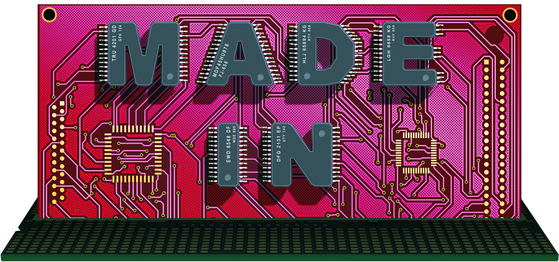[Column] A sense of crisis needed on the chip front
Published: 08 Jan. 2023, 19:58

The author is a professor of electrical engineering at Kaist.
The armed conflicts around the Korean Peninsula since the 16th century mostly stemmed from hegemonic ambitions between the continental powers of Russia and China dominating landmasses across Asia and maritime powers like the United States, Japan, Spain and Portugal expanding through the seas. The heated contest between the East Asian states and the Western maritime powers surfaced with the arrival of the Age of Exploration, when European seafarers competed to find new routes to America, India, Southeast Asia and East Asia thanks to their advanced maritime skills and technology.
The Japanese invasion of Korea in 1592 developed into a multinational war after the Ming Dynasty of China sent its forces to the Joseon Dynasty. The war resulted in historical regime changes across Korea, China and Japan. That was the first war causing a seismic change in the geopolitical dynamics around the Korean Peninsula. The First Sino-Japanese War in 1894 and the Russo-Japanese War in 1904 also can be explained in the context of hegemonic competition. The continental power had been the source of immense populations and resources, while the Pacific was a key channel for logistics of commodities and energy and coalition in the region.
The clash between the continental and maritime forces is ongoing. A contest over chip hegemony will continue in the new year. In an age of digital transformation, when machines are fast replacing the physical and mental labor of humans, the concept and role of labor, production and creativity —once exclusive to humans — is changing rapidly.
In particular, mental activity has been substituted by mathematical algorithms, or machine learning (ML) by artificial intelligence (AI). ML stores and builds data collected from physical space and virtual space of the metaverse. AI can be smarter, more precise and wiser than most people. As long as it is powered, it does not sleep. Individuals, companies and nations with supremacy in ML and AI can have global predominance.
For AI to perform ML, they require supercomputers and massive data storage, a collection of which is called “hyperscale data centers.” A pivot to such facilities is high-performance semiconductors. In other words, the capacity of AI depends on chips. Global supremacy in AI cannot be attained without competitive chip technology.
On Jan. 10, 1950, U.S. Secretary of State Dean Acheson under President Harry Truman introduced the so-called Acheson Line, stretching from the Aleutian Islands to the Philippines in the Pacific for U.S. protection of allies from the Soviet Union and China. South Korea, Taiwan and Indochina were excluded from the protection.

Today, a new type of the Acheson Line is being drawn to rally semiconductor producers around America to keep advanced chip technology and industries safely away from those continental forces. The new line cuts across South Korea — home to global memory majors like Samsung Electronics and SK hynix — and extends to Taiwan, home to foundry giant TSMC. A chip factory being built by TSMC in Kikuyomachi, Kumamoto Prefecture, Japan will be protected by the U.S. as it is placed inside the virtual boundary.
Under such volatile circumstances, governments have struck a strategic alliance and at the same time are taking discriminative steps in their own way to strengthen their chip competitiveness. The U.S. has been curbing exports of advanced chipmaking equipment to China to help contain its ever-expanding ambitions. America is also expected to restrict exports of electronic design automation (EDA) software to keep China’s chip production ability at bay. The U.S. could further act to control the outflow of chip designers to China. Washington has been pressing Samsung Electronics and TSMC to move — or build — chip factories in the U.S. to spread out foundries and memory chip facilities currently concentrated in East Asia to reduce their geopolitical risks. U.S. President Joe Biden signed the Chips and Science Act earmarking $280 billion spending to support chip industries on U.S. turf.
Meanwhile, Taiwan has been cementing ties with Pacific countries while building chip plants in America and Japan for greater security guarantees at the same time. On Dec, 6, TSMC broke ground on a $12 billion foundry in Arizona. It also started construction of a $8.6 billion facility in Kikuyomachi. Japan has teamed up with IBM and TSMC to rebuild chip infrastructure based on its competitiveness in materials, parts and equipment.
China’s chip competitiveness will be dealt a critical blow from sanctions from America. It could take a considerable period of time for China to regain the competitiveness. Its chip industry will likely rely on domestic demand for low-performing processors and memory for a while. It will have to survive on domestic demand and government subsidies. The Chinese government has pledged more than 1 trillion yuan ($143 billion) to promote its chip industry for five years from now.
South Korea must devise a more prudent — yet decisive — chip strategy to stay competitive. The most important thing is to acquire core chip technologies through relentless innovation to sustain the technological edge over Chinese, Japanese and U.S. companies. As memory demand will remain as long as we use computers, Korean chipmakers must continue to develop memory chips in ultra-nanometer and high-density architecture.
Korean chipmakers also must catch up with TSMC in terms of foundry capacity. Commercialization of the engineering process in 3-nanometer gate-all-around (GAA) could be a game changer. They must expand the market through partnerships with global enterprises with outstanding technology and services. Advanced packaging also could offer another edge. Materials, parts and equipment for top-notch packaging will provide new opportunities for them.
Last but not least, the government must develop system chips over the long haul. They require computer architects who can design entire systems, including algorithms and software and hardware. At the same time, the government and industry must groom chipmakers to sustain the growth of electric vehicles. Those chips are essential for space exploration and defense, too.
The government must support advances in basic sciences, build a business-friendly environment, and nurture top talent for the chip industry. It must enact laws and earmark budgets. The government support will help companies scale up. For their part, companies must acquire top-caliber manpower. To beat competition from the U.S., China, Taiwan and Japan over memory, foundry and system chips, at least 10,0000 people with postgraduate degrees in materials, parts and equipment studies are needed. To achieve that goal, universities across the country must open more than 10 departments for chip majors and 10 graduate schools specializing in chips. Even when they produce 1,000 graduates a year, that number will not be enough to keep up with the demand. Fostering chip talent is not a choice, but a must for the country.
Geographically, Korea is a peninsula. It can be a perfect maritime base to reach out beyond the Pacific. The country is no stranger to risks and the opportunities that accompany them. But after watching many regressions in the K-Chips Act that finally passed the National Assembly in December, Korean politics are as outdated — and nearsighted — as in the Joseon Dynasty, which ended up succumbing to the Japanese colonial forces. Sadly, the National Assembly and the government lack the urgency and historical awareness of the importance of our chip industry.
Translation by the Korea JoongAng Daily staff.










with the Korea JoongAng Daily
To write comments, please log in to one of the accounts.
Standards Board Policy (0/250자)